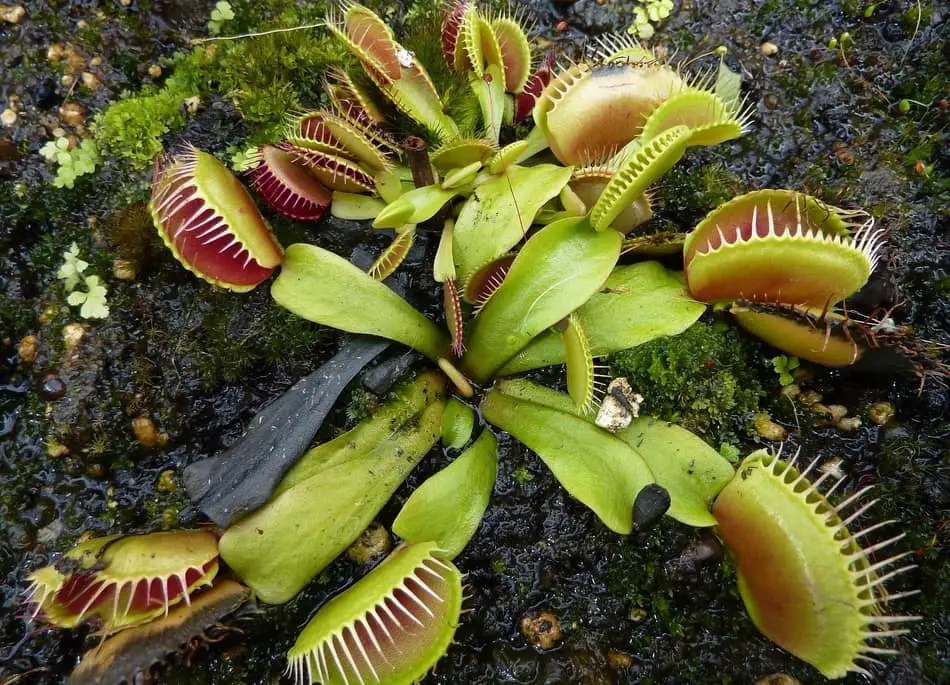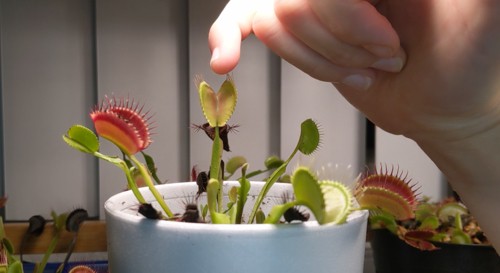When I first got a Venus flytrap, I was intrigued by the traps. But, I was not sure if touching a Venus flytrap could hurt or even kill it.
Touching a Venus flytrap won’t kill the plant. Poking the traps and activating them won’t kill the leaves immediately, but it will weaken them. The leaves have a limited lifetime; they wither after closing a couple of times.
Do you want to learn how to handle a Venus flytrap? This article will give you some tips for the best results.
Is Touching a Venus Fly Trap Safe?
The leaves of a Venus flytrap are unique. They exhibit bright colors and look like tiny jaws. In this section, you will learn if it is safe to touch a Venus flytrap.
Effect on the Venus Flytrap
Venus flytraps are native to South Carolina and North Carolina. It wasn’t until a few years ago that they became a popular plant pet.
Venus flytraps, like most plants, prefer not to be touched. Touching the plant causes stress. Also, it triggers the plant to lose leaves and lowers its photosynthetic ability.

Touching a Venus flytrap in different areas will generate different effects.
Bare root Venus flytraps come without a pot. They are shipped enclosed with water retaining materials such as mesh. The roots of the plant are long. They are black in color and very resilient. As an owner, you must treat them with care. But, overall, they can handle some touch during potting or repotting.
The bulb of the plant is the origin spot for the leaves. The bulb is white and has a firm exterior consistency and soft within. The bulb of the plant is delicate. You can touch the bulb as long as it is handled with care. Any piercing with your nails could damage the plant.
Touching a Venus flytrap inside its traps will trigger them to close. The leaves close when they receive the appropriate stimuli.
Closing the traps by poking them won’t kill the plant. But it will weaken it. Each of the leaves has a limited lifetime. After the lobes have closed a couple of times, it will lose its trapping capabilities and start to wither. Also, the plant will waste energy controlling those traps in an unnecessary motion.
It is normal for some leaves to wither in a Venus flytrap. These plants grow rapidly. They are continually producing new leaves as old ones start to wither. However, when poking the plant, you are accelerating the withering process. And a new young leaf is not ready to take over. With a lower number of leaves, the plant has a smaller photosynthetic area, which weakens it.
The Venus flytrap spends substantial amounts of energy controlling the traps. Activating the traps without purpose will cause stress and waste the plant’s energy. Generally, playing with the traps without actually feeding the plant can slow down its growth.
Venus flytraps have evolved to become successful predators. Their goal is to avoid closing their traps without prey.
Effects on Humans
Venus flytraps have become popular choices for exotic houseplants. They are sold in general stores, and some families buy them as a project for kids or adults alike.
Venus flytraps are harmless to humans. Their traps, which only extend to a maximum of 1.5 inches in size, are too small and weak to harm humans. It is safe to keep a Venus flytrap indoors.
Touching a Venus flytrap through the base of its leaves causes no effect. That area is just like any other leaf you encounter in the past.
The traps are a different area. They are usually opened and have cilia in their outer border. The cilia surrounding the lobes are soft. A human can safely introduce their finger inside a trap without any risk of sharp edges.
The leaves of a Venus flytrap are made up of two lobes. Inside each of the lobes are three trigger hairs. The trap closes only if something has touched the trigger hairs twice within a few seconds.
The first time people see a Venus flytrap, they tend to try to poke the traps and close them. Sometimes they are unsuccessful because they are unaware of the trigger hairs.
Suppose a human pokes inside a trap and wiggles their finger around the trap. The lobes will close after receiving the appropriate stimuli. You will feel the pressure of the lobes trying to grab you. But, the strength of the plant is not even close to keeping you there. You can easily take out your fingers from inside the trap. The lobes will remain closed, but the trap will reopen within 24 hours.
A human could also attempt to leave their finger in a trap for a while. The plant starts producing enzymes after capturing prey. Those enzymes can break up human flesh. But, due to the scale, the plant could only decompose tiny pieces of flesh.
Tips to Handle Venus Flytrap
You have learned about the effects of touching a Venus flytrap. Humans are safe to touch these plants, but the plant might weaken or even die due to improper care. I have summarized some tips below to ensure you handle your plant correctly and do not end up harming it.
- Do not expose the roots of the plant often: The roots of the plant are delicate. They can be touched, but they should not be broken. Generally, avoid exposing the roots of the plant. Only extract the plant from its pot once a year, during repotting, or for an emergency such as root rot or plagues.
- You can activate the traps, but only during feeding: Activating the traps weakens the plant. But, as an owner, you might be interested in observing how your plant works. There is an entirely safe way to do it: feed your plant. Venus flytraps benefit from capturing prey. They extract key nutrients that help them boost their diet.
Feeding a Venus flytrap is a fun and unique process. If done correctly, it is completely safe for the plant. Before you experiment with feeding a Venus flytrap, make sure to read this article: Venus Flytrap Feeding Guide. It outlines all you need to know about feeding a Venus flytrap effectively. The process is not complicated, but without a few tips, you could make mistakes.
- Avoid unwanted stress for the plant: Place the Venus flytrap in an area away from any source of stress. If you have a curious pet, opt for a room where the pet is not allowed. Or, consider buying hanging planters to keep the plant away from pets or humans (Venus flytraps are a bit of a novelty; many of my friends try to poke my plants as soon as they see them).
- Chose an appropriate home for the plant and stick to it: It isn’t easy to keep a Venus flytrap healthy as a novice owner. Avoiding any extra stress to your plant helps the plant grow without disturbances. Be very strategic when choosing a placement for your plant. Then, only move it if it is struggling or needs exposure to colder weather during dormancy.
- Trim only when necessary without pulling: Venus flytraps produce black leaves often. Feel free to trim the black leaves when they have completely dried up. However, you must always trim them with scissors. Never pull dead leaves. Pulling them can harm the bulb and even split the whole plant in half!
Other Venus Flytrap Care Considerations
I hope you found the tips useful. Owning a Venus flytrap is a unique experience and a challenge. Venus flytraps are safe for humans and pets. But, we might be the ones that end up killing the plants.
Besides touching the plant, there are many more considerations to follow when caring for Venus flytraps. For example, they can’t be watered with tap water or potted in standard potting soil. Also, some pot materials can kill Venus flytraps. To solve everyone some trouble, I made a Venus Flytrap Care Sheet. You can download it as a PDF format and save (or print) it for your records. You will get some necessary information for beginners, but also some advanced details.


